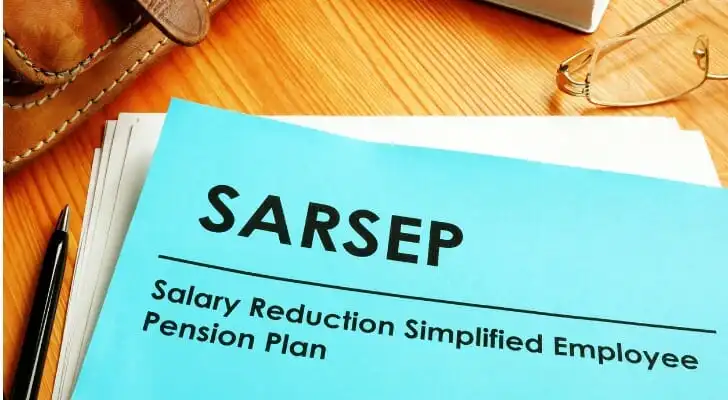A Salary Reduction Simplified Employee Pension Plan (SARSEP) is a specialized retirement plan that used to be available to employees of small businesses. While these plans could not be established after 1996, those established prior to 1997 still exist. SARSEPs were an early predecessor of the modern Simple Incentive Match Plan for Employees, commonly called SIMPLE plans. If you still have a SARSEP or are offered one, a financial advisor can help you determine what to do with it.
What Is a SARSEP?
A Salary Reduction Simplified Employee Pension Plan (SARSEP) is a type of Simplified Employee Pension (SEP) plan specifically available to small businesses. These plans predated the wide adoption of 401(k) plans and were an excellent way for people to save for retirement.
SARSEPs could no longer be established after 1996, with the passing of the Small Business Job Protection Act of that same year. Existing SARSEPs are allowed to enroll new employees who qualify for them, so you may still run into one. As more time passes, they are becoming less common, as employers opt for newer options like SIMPLE plans.
How Do SARSEPs Work?

A SARSEP allows employees of small businesses to make pretax contributions to retirement accounts through payroll deductions. SARSEPs must set up accounts for each eligible employee. These accounts can be set up with banks, insurance companies and other qualified financial institutions.
SARSEP contributions can be made to individual retirement accounts (IRAs) or annuity plans set up under the SARSEP. All contributions are 100% vested. Employees have control over how their money is invested within their accounts for plans using IRAs instead of annuities.
Employers can contribute to the SARSEP for their employees, but matching contributions are not allowed. Employer and participant contributions are subject to an annual addition limit. In 2023, total contributions are capped at 100% of the employee’s compensation (up to $330,000) or $66,000, whichever is less.
The employee contribution limit for SARSEPs follows the annual 401(k) contribution limit, which is $22,500 in 2023.
What Are the Rules for a SARSEP?
SARSEPs must have 25 or fewer employees and have been established prior to 1997. For a SARSEP to be maintained, it must meet the following requirements each year according to the IRS:
- 25 or fewer employees were eligible to participate in the SARSEP in the preceding year
- At least 50% of the eligible employees choose to make salary reduction contributions this year
- The elective deferrals of highly compensated employees meet the SARSEP deferral percentage limitation
Employers can establish rules for which employees are eligible for the SARSEP. For example, they can require that an individual must have been employed with the company for three out of the last five years to be eligible. They can also exclude nonresident employees or employees covered by a union that includes retirement benefits.
While the IRS does let companies create their own rules for who is and isn’t an eligible employee, rules must be applied uniformly and fairly. For example, while a company can use things like tenure to determine who is eligible, it cannot use gender or race to determine eligibility.
What Replaced the SARSEP?
The SARSEP was replaced by the Simple Incentive Match Plan for Employees (SIMPLE). SIMPLE IRAs were created through the Small Business Job Protection Act of 1996 to expand retirement options for small business owners and their employees.
SIMPLE plans have several improvements over SARSEPs. They allow larger small businesses of up to 100 employees to participate as opposed to the SARSEPs 25-employee limit. They also require employers to make annual matching contributions to plans.
Do You Have to Roll Over Your SARSEP?

If you leave your job with a SARSEP, you do not have to roll over your SARSEP plan. However, you if you want. Employees are allowed to roll over their SARSEP contributions and earnings tax-free to other IRAs and retirement plans.
If you’re happy with the management fees and investment options in your SARSEP, there’s no real reason to roll it over. Funds in your SARSEP follow the same rules as funds in a Traditional IRA.
You’ll have to take out required minimum distributions (RMDs) from your plan once you reach age 73 (. If you’re an early retiree or even retire at the traditional age, you may want to start rolling over money in your SARSEP to a Roth IRA to reduce RMDs later. If you’re considering this, it’s a good idea to check in with a financial advisor specializing in tax planning to see which strategy implementation will serve you best in the long run.
The Bottom Line
SARSEPs are rare retirement plans established before 1997 for employees of small businesses. You’re unlikely to run into one, but if you’re a new employee of a small business with a SARSEP plan, you can be grandfathered into it. For people with existing SARSEPs, you can choose to leave your money in your plan or roll it over into other retirement accounts like a traditional IRA or Roth IRA. Money in your SARSEP is treated like traditional IRA money, which will be subject to RMDs starting at age 73.
Tips to Save for Retirement
- A financial advisor can help you plan for retirement and finding an advisor doesn’t have to be hard. SmartAsset’s free tool matches you with up to three vetted financial advisors who serve your area, and you can interview your advisor matches at no cost to decide which one is right for you. If you’re ready to find an advisor who can help you achieve your financial goals, get started now.
- Having a plan for your retirement savings is key. Our retirement calculator can help you determine how much you’ll need to save to fund your retirement and tell you whether you’re on track.
Photo credit: ©iStock.com/designer491, ©iStock.com/pinkomelet, ©iStock.com/designer491
